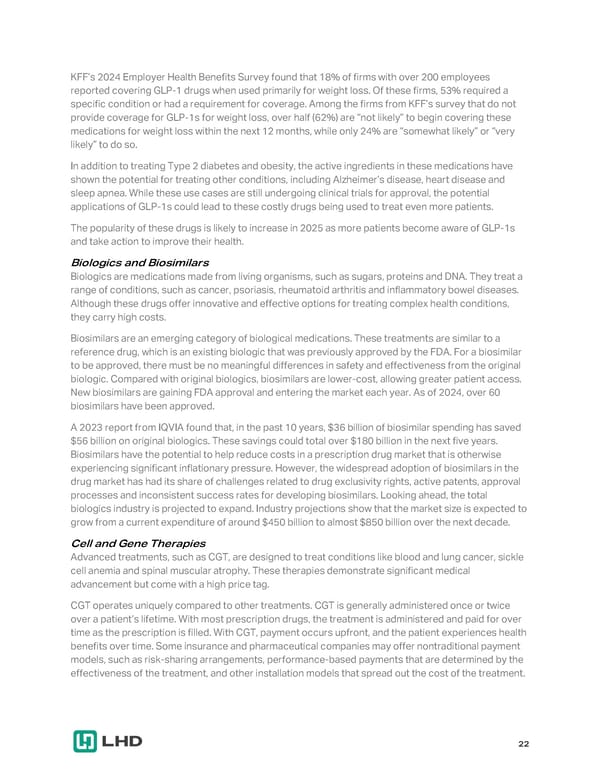KFF’s 2024 Employer Health Benefits Survey found that 18% of firms with over 200 employees reported covering GLP-1 drugs when used primarily for weight loss. Of these firms, 53% required a specific condition or had a requirement for coverage. Among the firms from KFF’s survey that do not provide coverage for GLP-1s for weight loss, over half (62%) are “not likely” to begin covering these medications for weight loss within the next 12 months, while only 24% are “somewhat likely” or “very likely” to do so. In addition to treating Type 2 diabetes and obesity, the active ingredients in these medications have shown the potential for treating other conditions, including Alzheimer’s disease, heart disease and sleep apnea. While these use cases are still undergoing clinical trials for approval, the potential applications of GLP-1s could lead to these costly drugs being used to treat even more patients. The popularity of these drugs is likely to increase in 2025 as more patients become aware of GLP-1s and take action to improve their health. Biologics and Biosimilars Biologics are medications made from living organisms, such as sugars, proteins and DNA. They treat a range of conditions, such as cancer, psoriasis, rheumatoid arthritis and inflammatory bowel diseases. Although these drugs offer innovative and effective options for treating complex health conditions, they carry high costs. Biosimilars are an emerging category of biological medications. These treatments are similar to a reference drug, which is an existing biologic that was previously approved by the FDA. For a biosimilar to be approved, there must be no meaningful differences in safety and effectiveness from the original biologic. Compared with original biologics, biosimilars are lower-cost, allowing greater patient access. New biosimilars are gaining FDA approval and entering the market each year. As of 2024, over 60 biosimilars have been approved. A 2023 report from IQVIA found that, in the past 10 years, $36 billion of biosimilar spending has saved $56 billion on original biologics. These savings could total over $180 billion in the next five years. Biosimilars have the potential to help reduce costs in a prescription drug market that is otherwise experiencing significant inflationary pressure. However, the widespread adoption of biosimilars in the drug market has had its share of challenges related to drug exclusivity rights, active patents, approval processes and inconsistent success rates for developing biosimilars. Looking ahead, the total biologics industry is projected to expand. Industry projections show that the market size is expected to grow from a current expenditure of around $450 billion to almost $850 billion over the next decade. Cell and Gene Therapies Advanced treatments, such as CGT, are designed to treat conditions like blood and lung cancer, sickle cell anemia and spinal muscular atrophy. These therapies demonstrate significant medical advancement but come with a high price tag. CGT operates uniquely compared to other treatments. CGT is generally administered once or twice over a patient’s lifetime. With most prescription drugs, the treatment is administered and paid for over time as the prescription is filled. With CGT, payment occurs upfront, and the patient experiences health benefits over time. Some insurance and pharmaceutical companies may offer nontraditional payment models, such as risk-sharing arrangements, performance-based payments that are determined by the effectiveness of the treatment, and other installation models that spread out the cost of the treatment. 22
 2025 Employee Benefits Market Outlook Page 21 Page 23
2025 Employee Benefits Market Outlook Page 21 Page 23